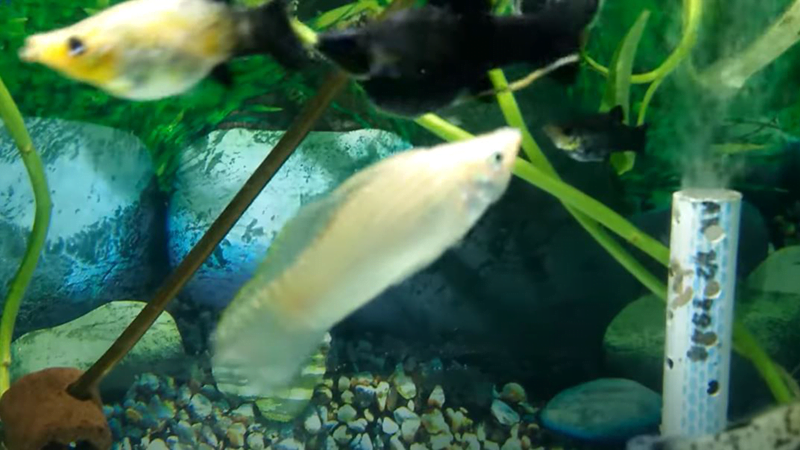Rare Molly fish colors, do you concern about it?
First, let’s find out what makes these guys so unique. This kind of fish is known as the Molly fish and is commonly found in the states of Texas, Florida, California, and Virginia. Its official name is Poecilia Latipinna. It’s not uncommon to see Molly in home aquariums, either. It does not necessitate the expertise of a fish expert, making it simple to reproduce. While it is in your aquarium, this species of fish can simply reproduce.
Overview Of Different Molly Fish Colors
Traditionally, Mollies possess three primary colors: white, black, and orange. As a function of selective breeding, the wide-range, beautiful, and unique color patterns of this fish community have come out. Here are some possible molly fish colors you may find in the market:
| Color | Description |
| Silver- | Actually closer to the shade of White. |
| Gold- | Usually has a combination of Yellow and Orange colors. |
| Black- | Has a shade of Black Velvety. |
| Red- | Usually combined with Orange, and sometimes accompanied with beautiful Pink Eyes. |
| Dalmatian- | Has a White body with Black Spots. |
| Marble- | Has Black, Orange, and Yellow Spots. |
| Platinum- | Actually closer to Silver color, and usually glowing when taken in black light. |
| Green- | Has some unique Green tones |
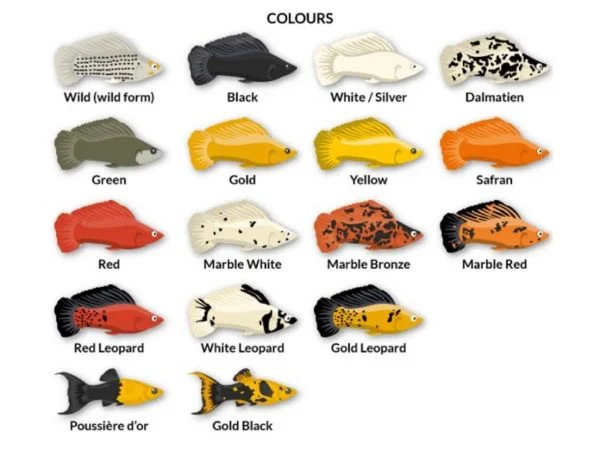
Related Articles:
16 Best-choice Types Of Mollies: Introduction & Tips Before Buying
1. Black Molly
This section will focus on the Black Common Molly, which is one of several black Mollies that can be found (Poecilia sphenops).
Occasionally, these fish have a golden line along with their fins that is entirely black. Although it is possible to find the color in nature, it is quite rare.
It is common for them to be about an inch smaller than the regular variety.
In a tank with a lot of light-colored plants and substrate, common black mollies look their best. It does well in water between 68 and 82-degrees Fahrenheit and prefers a tank that is larger than 30 gallons. Black Molly’s like when you keep the pH between 7 and 7.8.
Jet blackfish should be paired with vividly colored fish like expensive Guppies if you want them to draw more notice from onlookers.
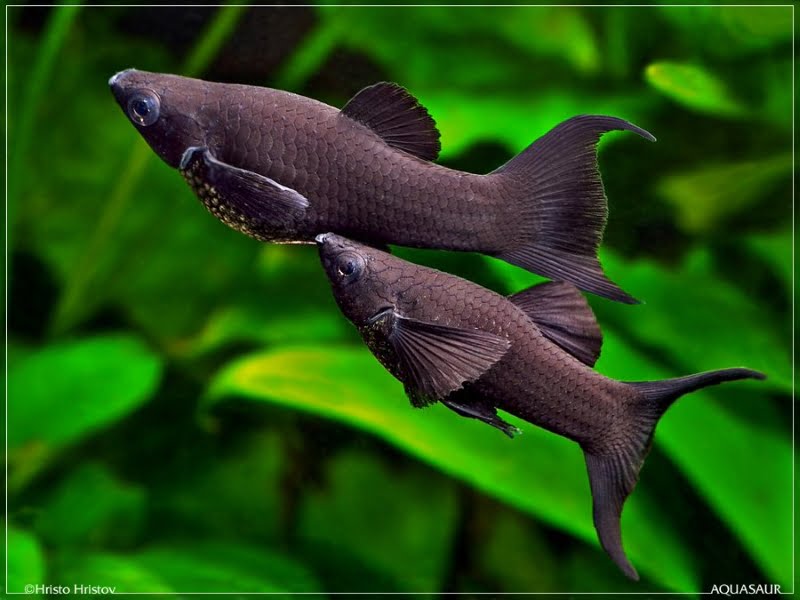
Other information and tips for you
- Color: Black
- Tail Type: Standard
- Lifespan: 3-5 years
- The cost ranges between $4 and $7.
2. Black Sailfin Molly
Black Sailfin is a melanistic subspecies of Sailfin Molly.
As is the case with the more common Black variation, it might have a yellow line along with the dorsal and caudal fins and a black body. On the other hand, this fish has a well-defined broad dorsal fin. Although it is a gentle breed, you must avoid housing them with fish that bite fins since they will become a target. Black Sailfins are a resilient breed that is excellent for beginners, reaching a maximum length of four inches. Despite their slightly greater size, they are satisfied to live in a 30-gallon tank and enjoy having a variety of hiding spots.
It can reach a length about an inch greater than the Lyretail.
Black Sailfins look their best in tanks that are light in color and resemble tropical mangrove forests. Mangrove roots can even be used to adorn their habitat.
Other information and tips for you
- Color: Black
- Tail Type: Standard or Lyre
- Lifespan: 3-5 years
- The cost ranges between $5 and $12.
3. Black Lyretail Molly
The Black Lyretail might be all black or a combination of black and grey tones. They have iridescent scales that contrast beautifully with light-colored plants and decorations. The caudal fin of all Lyretails is forked. Their dorsal fin is elongated and broad, resembling a ship’s sail.
This is a gregarious and active fish that travels in groups of at least five. Because they are such graceful and slow swimmers, they should be housed in a tank with limited flow. To create a tranquil current, you can use a hang-on back or an under gravel filter.
They can be kept in the same enclosure as other Mollies and livebearers. They are an excellent tank partner for Swordtails.
Other information and tips for you
- Color: Black
- Tail Type: Lyre
- Lifespan: 3-5 years
- The cost ranges between $5 and $12.
4. Dalmatian Molly
Dalmatian Mollies, like Dalmatian dogs, have black spots all over their bodies!
As the most common color, white can also be found in a variety of other shades, including black and blue.
In a tank with a lot of vividly colored plants and other schooling fish, these fish are sure to draw attention. It’s very hardy and can last quite a while in water outside the ideal temperature or pH range, mostly because water is not too hard to keep within the 68-82-degree temperature guidelines. The recommended pH of the water is 7 to 7.8. The Dalmation Molly is happiest in tanks larger than 30 gallons and can grow to reach almost five inches. Additionally, you can add Guppies, Swordtails and other micro fish to your molly tank.
Other information and tips for you
- Color: Spotted
- Tail Type: Standard or Lyre
- Lifespan: 3-5 years
- The cost ranges between $4 and $8.
5. Common Molly
It’s hard to go wrong with the common Molly as a good choice for starters.
This fish is available in a variety of colors, including red, orange, black, yellow, and marbled. Gray or light tan is the color of wild-type specimens.
Originally from Central America, it has since spread to the Caribbean and the southern United States.
As a newbie, this species should be your starting point. You don’t need any particular equipment to take care of it. A 20-gallon tank is required for a school of five. Decorate the tank with logs, driftwood, bogwood, and mangrove roots. If you don’t have access to mangroves, you can utilize tree roots instead.
The ideal plants to utilize are Tapegrass, Hornwort, or Sagittaria if you want to include plants in your setup.
Small to medium-sized schooling fish will get along well with these species, making them ideal for communities. Fish like Platys, Swordtails, Guppies and Danios are good tankmates for these livebearers.
Other information and tips for you
- Color: Various
- Tail Type: Standard
- Lifespan: 3-5 years
- The cost ranges between $4 and $10.
6. Balloon Belly Molly
Balloon Belly Molly’s moniker comes from their distinctive shape, which gives them the appearance of being overweight. They come in three colors: white, black, and yellow, and feature a back fin shaped like a lyre. Molly with a Balloon Belly has a round stomach.
This uncommon characteristic is capable of being bred into any existing species but does not occur naturally.
While Balloon Bellies are adorable, they do have a few disadvantages and require more advanced care and extra attention.
Their body form impairs their coordination and buoyancy, causing them to move slowly. Due of their poor swimming speed, they have a difficult time keeping up with tank mates. Additionally, they must be fed at a different mealtime than the rest of your fish to avoid being out-competed for food.
Additionally, the feature limits their growth to three inches or fewer and can shorten their lifetime by a year or two.
Above all, this variety is best kept by knowledgeable caretakers.
Other information and tips for you
- Color: Various
- Tail Type: Standard or Lyre
- Lifespan: 2-4 years
- The cost ranges between $6 and $8.
7. Gold Dust Molly
Gold Dust is available for Lyretails, Commons, and Sailfins.
The body of this species is golden yellow, with a black-spotted tail. Some specimens also have black spots on their heads and bodies. These fish can grow to be 4 inches long and really shine in groups of 6 or more.
The golden hue ranges from bright yellow to deep orange.
This molly will require a 30-gallon tank to house a group of this size. As they zip around the tank, they are extremely playful and entertaining to watch. They stand out even more when paired with a school of Black Mollies.
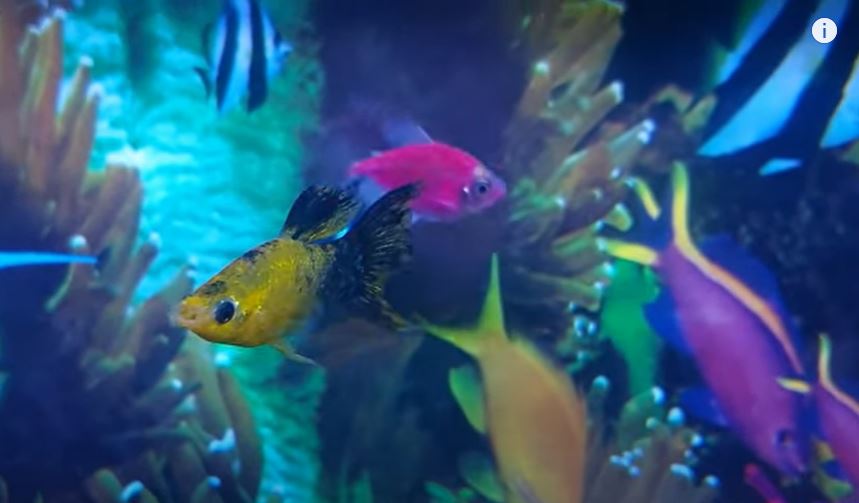
Other information and tips for you
- Color: Gold and black
- Tail Type: Standard or Lyre
- Lifespan: 3-5 years
- The cost ranges between $5 and $7.
8. Gold Doubloon Molly
The Gold Doubloon Molly is highlighted by a vibrant yellow and black color scheme that will stand out in any tank. Due to the fact that it has short fins but demands a considerable amount of swimming space, we recommend a tank larger than 30 gallons. It is a resilient fish that thrives in a wide range of temperatures and can reach a maximum length of five inches.
Other information and tips for you
- Color: Gold and black
- Tail Type: Standard or Lyre
- Lifespan: 3-5 years
- The cost ranges between $8 and $10.
9. Marble Molly
A Marble Molly has dense black spots that cover its white body and fins and resembles the Dalmatian in appearance.
This graceful color variation is found in both Common and Lyretail types.
As with all Mollies, they require non-acidic water with a hardness of at least 15 dGH. They are most striking against a light-colored substrate. Utilize light-colored pebbles, logs, driftwood, and bogwood to replicate the look of a tropical bay habitat in their setting.
They should be kept in an even number of students, with a greater proportion of females than boys. Males exhibit aggressive behavior when they are competing or attempting to attract a mate.
Other information and tips for you
- Color: Various, with marble pattern
- Tail Type: Standard or Lyre
- Lifespan: 3-5 years
- The cost ranges between $4 and $8.
10. Creamsicle Molly
This vibrant tiny fish is orange with a white bottom and resembles the frozen treat after which they are named. They can be found in their color form on Commons, Sailfins, and Lyretails.
Creamsicles are more raucous in nature than other color types. They are more likely to hunt and nip at their tank mates and other fish.
To maintain order, groups should consist of at least six people.
When no rivalry exists within the group, these fish should be benign toward their own species and tank mates. They are suitable for keeping alongside Danios, Corys, Tetras, and other livebearers.
Other information and tips for you
- Color: Orange and white
- Tail Type: Standard or Lyre
- Lifespan: 3-5 years
- The cost ranges between $4 and $8.
11. Yucatan Molly
This largest molly has a dorsal fin that is far longer than that of a regular Sailfin.
This species is better suited to keepers with more expertise. It is slightly more sensitive to changes in water temperature, and greater care must be given when establishing its habitat. It necessitates more accurate temperature, pH, and salinity ranges. Additionally, it is difficult to breed, making it a relatively unusual find.
A 30-gallon tank can house a breeding couple, but a school will require at least ten additional gallons.
Males’ dorsal fins might collapse and fold upon themselves if their tank is too tiny.
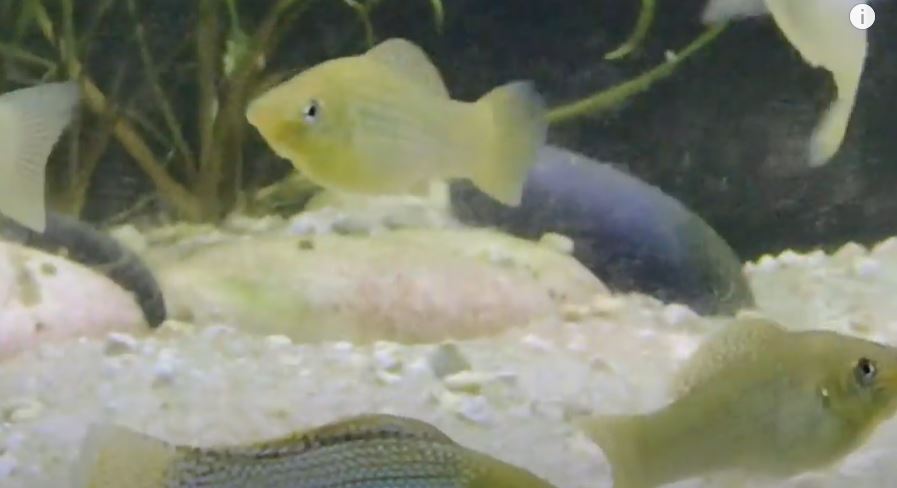
Other information and tips for you
- Color: Grey or bronze
- Tail Type: Standard
- Lifespan: 3-5 years
- The cost ranges between $5 and $12.
12. Liberty Molly
Liberty is a somewhat uncommon Molly found only in El Salvador.
It is so named due to its vibrant red, white, and blue hues. It has a white or silver body with red, orange, black, or blue fins. Additionally, a marbled variation is offered.
It has a broad dorsal fin similar to Poecilia latipinna. It reaches a maximum length of 3 inches and the males exhibit the most vibrant colors.
This species is slightly more aggressive than others, and has been known to fin nip and harass tank mates. As a result, it is preferable to keep it in a single species setup. Aggression grows as the number of males in a group increases, thus maintaining a larger female to male ratio to maintain peace.
Other information and tips for you
- Color: White/silver with red fins and black/blue spots
- Tail Type: Standard
- Lifespan: 3-5 years
- The cost ranges between $8 and $10.
13. White Sailfin Molly
This is either Poecilia latipinna or Poecilia velifera in a white color variant.
White Mollies stand out in darker tanks, which allows you to utilize darker substrate and plants with darker green leaves. This breed can grow to be five inches in length, making it one of the larger breeds suitable for the aquarium. Due to the fact that their white color is not due to albinism, they do not suffer from the same health and eyesight difficulties as many albino fish.
They are as easy to care for as any other Sailfin, making them a perfect starter fish.
A 30-gallon or larger tank is preferable. A more intriguing fact is that they are incredibly hardy fish that thrive in water with a pH of 7 to 8.
Other information and tips for you
- Color: White
- Tail Type: Standard
- Lifespan: 3-5 years
- The cost ranges between $5-and $10.
14. Platinum Lyretail Molly
The Platinum Lyretail is made of solid silver with shimmering scales. It swims with a graceful gait and has a forked tail. Despite its beauty, it is simple to maintain and does not cost a lot of money. Because they require salt in the water, they must be housed with fish that are tolerant of a saltwater environment.
This color variant can be found in either P. velifera or P. latipinna.
Look at the dorsal fin to tell the two species apart. P. velifera has a much taller and wider dorsal fin than P. latipinna and can grow up to an inch larger.
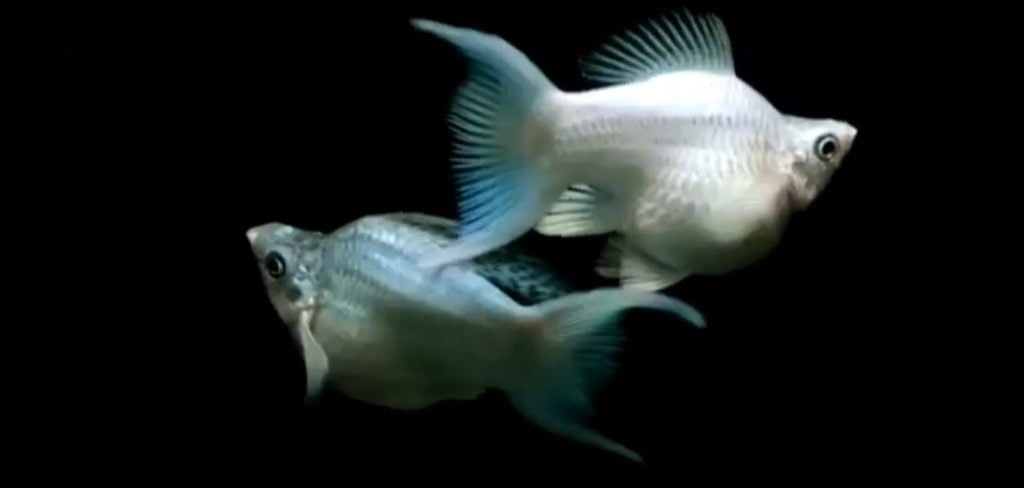
Other information and tips for you
- Color: Silver
- Tail Type: Lyre
- Lifespan: 3-5 years
- The cost ranges between $5 and $10.
15. Atlantic Molly
The Atlantic Molly, also known as the Mexican Molly (or Amazon Molly), is very similar to the Common Molly. It can grow up to 3 inches long and comes in a variety of colors.
The Atlantic Molly’s natural color is grey, with orange or yellow highlights and fins. Some have had their fins bred for iridescence or black pepper spots. Some are platinum in hue, with a glittering sheen.
A 30-gallon tank can house a school of six fish and allow each fish to grow to its full size. The water temperature should be between 73 and 80°F, and the water hardness should be greater than 15 dGH.
This species is found in tropical inlets, so your tank should be set up to replicate this environment. Include a variety of logs, roots, and freshwater plants that can withstand higher salinity levels.
As a result of parthenogenesis, every individual of this species is born a female. So they don’t require a mate to have children. There are fewer people who know about it because of its rarity. This species can only be found in a specialized keeper’s aquarium.
Other information and tips for you
- Color: Grey/tan with yellow/orange fins
- Tail Type: Standard
- Lifespan: 3-5 years
- The cost is $3 or more.
16. Wild Type
In the wild, mollies aren’t quite as eye-catching. Selective breeding, crossbreeding, and hybridization in captivity have produced the colors we are familiar with. It is true that a wild Molly can enable you to create a more realistic brackish habitat.
There are a variety of shades of grey, bronze, and tan among the Wild Types.
A few have yellow highlights on the edges of their fins; for the most part, they are unadorned. Your tank will seem more natural if you include a few pieces of driftwood. Mangrove swamps benefit greatly from their use.
To add color to a tank consisting of wild-type fish, you can use additional fish. Attracting fish like tetras, guppies, and gouramis.
Other information and tips for you
- Color: Grey, bronze, tan
- Tail Type: Standard
- Lifespan: 2-5 years
- The cost ranges between $3 and $8.
Video: Rare Molly Fish Colors
FAQs
What is the rarest molly fish?
The world’s most elusive molly, the black molly fish is bred in Singapore’s aquaculture facilities. Even the Mexican sailfin molly, or the short-finned molly, is extremely rare. Yucatan Molly is another name for the Mexican sailfin. It is found only in Mexico’s Yucatan Peninsula and is gray or bronze with iridescent scales. Taller than a conventional Sailfin dorsal fin, it is its most distinguishing feature. Even in an aquarium, they are tough to breed.
What is 24K molly fish?
It is also known as Cheetah Molly fish or 24K Molly fish. Mollies have a three- to four-year life expectancy. They will begin to suffer from the disease when they are ancient, but they will still be able to give birth. There are two options when sick and deformed fish appear: either care for them until they die or feed them to your carnivorous pet fish.
Are there blue molly fish?
Until now, blue molly fish can’t be found in nature, but breeders and hobbyists have worked to develop one. According to an article published in Tropical Fish Hobbyist magazine, the F6 Poecilia petenensis generation produced two males and two females with blue on almost white bodies with black patterning in the fins and on the body.

Annette M. Chaney is an experienced marine biologist with over 20 years of experience as an aquarist and fishkeeper. She started her first aquarium at a young age, filling it with frogs and goldfish obtained from the ten-cent pet store.
Annette grew up caring for and breeding African Cichlids, which led to a hobby in high school that doubled as a profitable means. Attending Reed College gave her time to solidify herself as an accomplished aquarium caretaker with an eye for sales. After that, from 2009 – 2013, she studied at Roger Williams University – one of the most prestigious universities for Aquaculture and Aquarium in USA. She is the founder of AquariumCircle since 2010.
